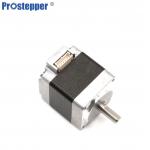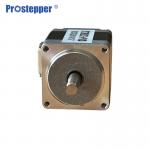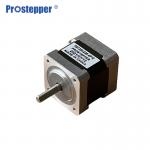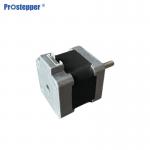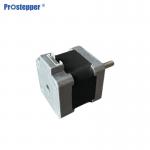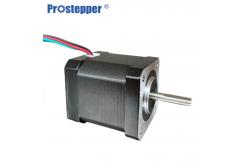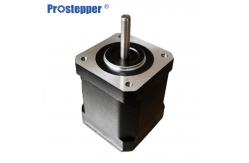1.8 degree hybrid stepper motor 2 phase stepping motor NEMA23 57mm
for 3d printer 0.9° and 1.8° Hybrid Stepper Motors1.8° Step Angle,The motors are directly compatible with the stepper
motor drive boards and also drive either motor (if required) in the
half step mode i.e. 0.9° per step resulting in higher resolution,
greater performance stability and faster stepping rates. Direction,
velocity, acceleration/deceleration can be controlled by a stepper
motor controller.,Applying the correct electrical pulse sequence to
the windings of the stepper motor results in a 1.8° step angle
rotation of the spindle (i.e. 200 steps per revolution). When
correctly loaded and driven these motors will produce discrete
output steps. The number of steps and speed of rotation are
determined by the number of pulses and frequency of the input
signal. This provides an ideal method for speed and position
control. The motors are directly compatible with stepper motor
drive boards. Description of 1.8 degree stepper motor - Accurate position Control
The angular displacement of the stepping motor can be precise
controlled by the number of electrical pulses.Angle accuracy can be
controlled within ±0.09°without any feedback devices. - Electromagnetic furnace optimization design, lift torque, reduce
temperature rise, so that the motor running smoothly
- The Fulling product line is sold to major manufacturing Companies
for Industry of automation, medical andhealth care equipment,
printer machine, packing device,Information Technology,household
appliance
product,AGV and automobile. - Stepper motors are economical, accurate, and easy to control, and
they can operate reliably in a variety of environments (depending
on the level of protection IP chosen) preferably in machines with
additional enclosures or in clean environments
- The material is selected from well-known manufacturers at home and
abroad. The advantages are light weight, good heat dissipation
performance, good thermal conductivity, die-casting, good
plasticity, higher elongation than iron, low noise, good motion
stability, the disadvantages are high price, low hardness
Specifications | Mode No | PST57H242-4P10 | PST57H242-4P20 | PST57H242-4P30 | | Holding Torque | 0.6N.m | | Related Current | 1A/Phase | 2A/Phase | 3A/Phase | | Resistance | 4.2 Ω/Phase | 1.2Ω /Phase | 0.51Ω/Phase | | Inductance | 8.9MH/Phase | 2.1MH/Phase | 1MH/Phase | | Inertia | 140g.cm2 | | Weight | 0.46kgs | | Length | 42.5mm | | Connection | P |
| Mode No | PST57H245-4P10 | PST57H245-4P20 | PST57H245-4P30 | | Holding Torque | 0.8N.m | | Related Current | 1A/Phase | 2A/Phase | 3A/Phase | | Resistance | 4.7 Ω/Phase | 1.25Ω /Phase | 0.57Ω/Phase | | Inductance | 10.8MH/Phase | 2.7MH/Phase | 1.2MH/Phase | | Inertia | 180g.cm2 | | Weight | 0.52kgs | | Length | 45.5mm | | Connection | P |
| Mode No | PST57H251-4P10 | PST57H251-4P20 | PST57H251-4P30 | | Holding Torque | 0.8N.m | | Related Current | 1A/Phase | 2A/Phase | 3A/Phase | | Resistance | 4.7 Ω/Phase | 1.25Ω /Phase | 0.57Ω/Phase | | Inductance | 10.8MH/Phase | 2.7MH/Phase | 1.2MH/Phase | | Inertia | 180g.cm2 | | Weight | 0.52kgs | | Length | 45.5mm | | Connection | P
|
Buyer's concerns |
